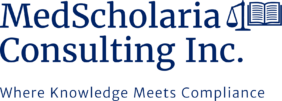
Management vs Case Management: What RNs Should Know
By Medscholaria Consulting, Inc.
California BRN-Approved CE Provider | CEP 18046
Introduction
As healthcare evolves, many registered nurses (RNs) are exploring non-bedside careers that use their clinical expertise in innovative ways. Two such pathways—Utilization Management (UM) and Case Management (CM)—are increasingly vital to patient care and system sustainability.
This guide breaks down the key differences and similarities between UM, UR (Utilization Review), and CM, and explains how they fit into the broader U.S. healthcare system. Whether you’re considering a career shift or you’re a policymaker evaluating workforce contributions, this post will clarify the critical roles these nurses play—and why their impact matters nationally.
What Is Utilization Management?
Utilization Management is a strategic healthcare process that ensures patients receive the right care, at the right time, in the right setting—and that the care is medically necessary and supported by clinical guidelines. It’s primarily a cost-containment and quality assurance tool used by insurers, hospitals, and health systems.
UM professionals, often RNs, evaluate treatment plans, procedures, admissions, and lengths of stay based on clinical criteria to prevent unnecessary services or delays in care.
Example: An RN UM reviewer may assess whether a patient being admitted for chest pain meets inpatient criteria or can be managed at an observation level based on InterQual or MCG guidelines.
What Is Utilization Review (UR)?
UR is a core component of Utilization Management. It includes three types:
- Prospective Review: Before care is delivered (e.g., prior authorizations)
- Concurrent Review: During care (e.g., ongoing inpatient care)
- Retrospective Review: After care is delivered (e.g., billing audits)
UM nurses are usually involved in concurrent review, collaborating with providers, payers, and interdisciplinary teams to ensure care stays appropriate and justified.
What Is Case Management?
Case Management is a patient-centered, collaborative process that plans, coordinates, and advocates for care across the continuum. CM aims to achieve optimal health outcomes by managing medical, social, and financial needs—especially for complex or high-risk patients.
Case managers often support:
- Discharge planning
- Care transitions
- Social determinants of health
- Resource access (e.g., rehab, home health, equipment)
They work with both insured and uninsured populations and are typically embedded in hospitals, clinics, health plans, or community settings.
Importantly, in many healthcare settings, case managers perform Utilization Management functions as part of their role—particularly when working with insurance companies to obtain authorizations, provide clinical justifications, or prevent denials. This blend of responsibilities is sometimes referred to as care coordination, where the CM ensures both appropriate care delivery and insurance compliance.
Key Similarities Between UM and CM
- Both roles rely heavily on clinical nursing judgment
- Both aim to improve patient outcomes and optimize resource use
- Both use evidence-based guidelines (e.g., MCG, InterQual)
- Both require excellent communication, documentation, and collaboration skills
How UM and CM Differ
| Feature | Utilization Management (UM) | Case Management (CM) |
| Primary Goal | Appropriate care utilization | Holistic patient-centered care |
| Focus | Medical necessity, level of care | Transitions, care coordination, outcomes |
| Guidelines Used | MCG, InterQual | May use guidelines but more flexible |
| Interaction | Limited patient contact, high payer/provider focus | Frequent patient and family interaction |
| Timing | Often real-time or retrospective | Often prospective and longitudinal |
Why Do We Use MCG or InterQual Guidelines?
These tools provide standardized, evidence-based criteria for determining medical necessity, ensuring fairness, consistency, and defensibility.
- MCG (formerly Milliman): Emphasizes evidence-based pathways and recovery timelines.
- InterQual: Focuses on appropriateness of care based on diagnosis and interventions.
Both are used by insurers and providers to reduce denials, prevent delays, and ensure high-value care.
Why Are Independent Review Requests (IRRs) Needed?
Even with guidelines, disagreements happen. Patients or providers may dispute a denial or level-of-care decision. IRRs are conducted by neutral third parties to:
- Provide due process
- Ensure regulatory compliance
- Support fair appeals
UM nurses often prepare or respond to IRRs, reinforcing the importance of solid documentation and clinical rationale.
National Impact and NIW Relevance
Your work in UM and CM contributes directly to the nation’s interest:
- Prevents unnecessary healthcare spending
- Ensures timely, appropriate care
- Improves patient satisfaction and outcomes
- Reduces provider burnout and administrative burden
By training and empowering nurses in these roles, we strengthen the U.S. healthcare system’s efficiency, access, and equity—core themes of the National Interest Waiver (NIW) framework.
Ready to Learn More?
If you’re an RN interested in transitioning to UM or CM, subscribe to our upcoming 1-hour CE course: “Getting Started in Utilization Management: Tools, Trends, and Opportunities.”
Stay connected with Medscholaria Consulting as we build the future of nursing through education, innovation, and national impact.
About Medscholaria Consulting
Medscholaria is a nurse-led, BRN-approved CE provider focused on empowering RNs in Utilization Management, Case Management, AI integration, and healthcare policy. Learn more at medscholaria.com.
